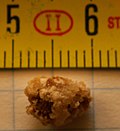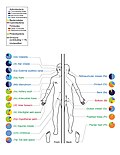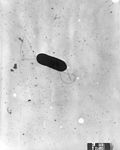Pathogenic bacteria are bacteria that can cause disease. This article focuses on the bacteria that are pathogenic to humans. Most species of bacteria...
79 KB (4,101 words) - 10:40, 13 April 2024
Pathogen (redirect from Pathogenic)
monocytogenes, and Salmonella. Other infectious diseases caused by pathogenic bacteria include tetanus, typhoid fever, diphtheria, and leprosy. Fungi are...
41 KB (4,224 words) - 02:21, 4 August 2024
include the model organism Escherichia coli, along with various pathogenic bacteria, such as Pseudomonas aeruginosa, Chlamydia trachomatis, and Yersinia...
24 KB (2,445 words) - 17:36, 19 July 2024
Plant disease (redirect from Plant pathogenic bacteria)
subtropical and tropical regions of the world.[page needed] Most plant pathogenic bacteria are bacilli. Erwinia uses cell wall–degrading enzymes to cause soft...
27 KB (2,413 words) - 19:08, 24 June 2024
for the actual reduction of bacteria to be enumerated. Demonstration of the extent of inactivation of pathogenic bacteria by milk pasteurization came...
48 KB (5,377 words) - 11:01, 19 August 2024
damage host cells. These pathogenic traits are encoded by virulence genes carried only by the pathogens. E. coli and related bacteria constitute about 0.1%...
54 KB (5,817 words) - 13:54, 7 July 2024
Kidney stone disease (section Pathogenic bacteria)
enhance stone formation. Some bacteria have roles in promoting stone formation. Specifically, urease-positive bacteria, such as Proteus mirabilis can...
132 KB (13,802 words) - 22:37, 18 August 2024
Escherichia coli (redirect from E. coli bacteria)
vitamin K2 or by preventing the colonization of the intestine by pathogenic bacteria. These mutually beneficial relationships between E. coli and humans...
107 KB (11,120 words) - 15:36, 7 August 2024
Quorum sensing (section Bacteria)
use quorum sensing to determine where to nest. Quorum sensing in pathogenic bacteria activates host immune signaling and prolongs host survival, by limiting...
81 KB (9,932 words) - 01:47, 22 August 2024
Food spoilage (redirect from Spoilage bacteria)
or may even be harmful to one's health. There are many species of pathogenic bacteria that target different categories of food. For example, Clostridium...
13 KB (1,580 words) - 20:49, 4 May 2024
Ligilactobacillus salivarius (category Bacteria described in 1953)
exert a range of therapeutic properties including suppression of pathogenic bacteria. Ligilactobacillus salivarius has been found to be of benefit in...
4 KB (333 words) - 09:49, 18 August 2023
coliform bacteria are not normally causes of serious illness, they are easy to culture, and their presence is used to infer that other pathogenic organisms...
16 KB (1,880 words) - 06:20, 27 May 2024
Microbiological culture (redirect from Cultured bacteria)
inoculated with the desired bacteria, the plates are incubated at the optimal temperature for the growing of the selected bacteria (for example, usually at...
20 KB (1,983 words) - 13:03, 17 August 2024
gram-positive bacteria are bacteria that give a positive result in the Gram stain test, which is traditionally used to quickly classify bacteria into two broad...
24 KB (2,648 words) - 14:57, 23 July 2024
Clostridium (redirect from Pathogenic clostridia)
test kit (Bactotype) for the detection of C. perfringens and other pathogenic bacteria. Clostridium species are readily found inhabiting soils and intestinal...
24 KB (2,339 words) - 05:14, 23 June 2024
particularly the ones in the gut. However, several species of bacteria are pathogenic and cause infectious diseases, including cholera, syphilis, anthrax...
143 KB (15,531 words) - 19:34, 31 July 2024
of pathogenic bacteria are likely to be present in the water. The coliform index is used because it is difficult to test for pathogenic bacteria directly...
2 KB (335 words) - 15:24, 10 December 2023
Mycoplasma pneumoniae (category Pathogenic bacteria)
(CARDS) toxin. The CARDS toxin most likely aids in the colonization and pathogenic pathways of M. pneumoniae, leading to inflammation and airway dysfunction...
37 KB (4,014 words) - 21:20, 16 May 2024
Streptococcus (redirect from Streptococcal bacteria)
cocci) or spherical bacteria that belongs to the family Streptococcaceae, within the order Lactobacillales (lactic acid bacteria), in the phylum Bacillota...
42 KB (3,765 words) - 22:34, 21 August 2024
Gut microbiota (redirect from Intestinal bacteria)
or allowing pathogenic bacteria to grow. Another harmful effect of antibiotics is the increase in numbers of antibiotic-resistant bacteria found after...
128 KB (14,234 words) - 01:17, 26 July 2024
Human microbiome (redirect from Bacteria and human health)
C-section harbors more pathogenic bacteria such as Escherichia coli and Staphylococcus and it takes longer to develop non-pathogenic, beneficial gut microbiota...
105 KB (11,667 words) - 23:41, 1 August 2024
Vibrio vulnificus (category Bacteria described in 1976)
a species of Gram-negative, motile, curved rod-shaped (vibrio), pathogenic bacteria of the genus Vibrio. Present in marine environments such as estuaries...
32 KB (3,525 words) - 15:51, 20 August 2024
Clostridium tetani (category Pathogenic bacteria)
each other than they are to any other genus. This cluster includes other pathogenic Clostridium species such as C. botulinum and C. perfringens. The closest...
12 KB (1,396 words) - 08:49, 18 August 2024
Endospore (redirect from Endospore-forming bacteria)
most endospores. The endospores of certain types of (typically non-pathogenic) bacteria, such as Geobacillus stearothermophilus, are used as probes to verify...
27 KB (3,179 words) - 11:54, 19 July 2024
Listeria monocytogenes (category Bacteria described in 1940)
Listeria monocytogenes is the species of pathogenic bacteria that causes the infection listeriosis. It is a facultative anaerobic bacterium, capable of...
42 KB (4,779 words) - 01:48, 3 August 2024
virus (HIV), or antibiotics being taken to kill other pathogens), pathogenic bacteria that were being held at bay can proliferate and cause harm to the...
14 KB (1,579 words) - 07:05, 30 June 2024
Foodborne illness (section Other pathogenic agents)
poisoning) is any illness resulting from the contamination of food by pathogenic bacteria, viruses, or parasites, as well as prions (the agents of mad cow...
74 KB (7,695 words) - 15:38, 27 July 2024
Rickettsia (category Pathogenic bacteria)
Queensland tick typhus (Australian tick typhus). The majority of pathogenic Rickettsia bacteria are susceptible to antibiotics of the tetracycline group. The...
26 KB (2,482 words) - 00:09, 1 August 2024
Streptococcus pneumoniae (category Pathogenic bacteria)
(diplococci) and do not form spores and are non motile. As a significant human pathogenic bacterium S. pneumoniae was recognized as a major cause of pneumonia in...
32 KB (3,298 words) - 02:10, 17 August 2024
Microorganism (section Bacteria)
medicine, as it has led to the development of multidrug resistant pathogenic bacteria, superbugs, that are resistant to antibiotics. A possible transitional...
73 KB (7,743 words) - 14:29, 21 August 2024




















